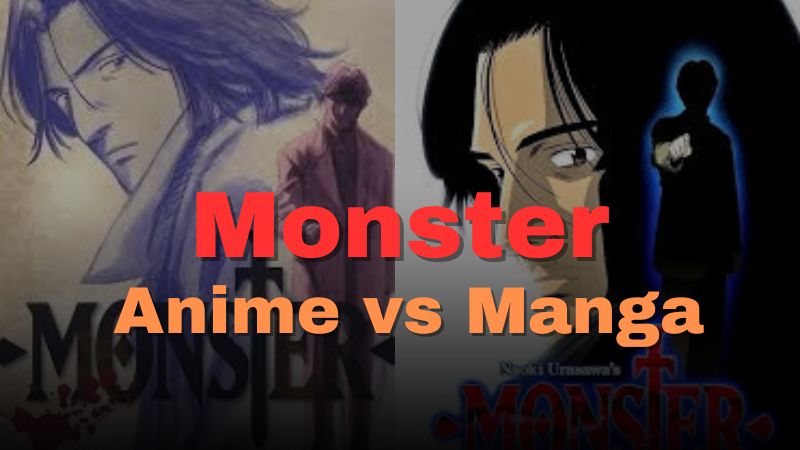Table of Contents
Monster, created by Naoki Urasawa, is known for its gripping story, intense psychological elements, and complex characters. While both the manga and anime adaptations stay true to these themes, there are notable differences in some scenes, pacing, and how certain plot points are handled. In this article, we’ll examine the key differences between Monster manga and anime, looking at specific scenes that were altered, expanded, or removed altogether—and decide which medium does each best.
Introduction: Monster Manga vs. Anime

Both the Monster manga and anime follow Dr. Kenzo Tenma’s journey as he attempts to stop the mysterious and deadly Johan Liebert. The manga, with 18 volumes, offers readers an in-depth exploration of themes, while the anime keeps close to the storyline but introduces changes in visuals, pacing, and even certain scenes. Below, we’ll dive into the most significant scene differences between the two versions.
1. Introduction of Johan Liebert
- Manga: In the manga, Johan’s presence is felt gradually through subtle hints and eerie depictions, which allow readers to feel the slow buildup of dread as his true nature is revealed. This approach emphasizes the psychological aspect of his character.
- Anime: The anime visually enhances Johan’s introduction with atmospheric lighting, music, and carefully paced scenes. These elements amplify his dark charisma and the ominous feeling he brings.
Which Does It Better? The anime’s use of audio-visual elements to enhance Johan’s introduction makes this scene more impactful, giving viewers a haunting first impression that adds to the mystery surrounding him.
2. The Hospital Scene with Dr. Tenma’s Moral Dilemma
- Manga: In the manga, Dr. Tenma’s moral struggle—choosing between saving a powerful official or a child—is portrayed with detailed internal dialogue. This helps readers grasp the gravity of Tenma’s decision and sets the stage for his moral convictions.
- Anime: The anime builds on this scene with emotional music and a slow buildup, showing Tenma’s facial expressions and the tension he feels.
Which Does It Better? The manga’s internal dialogue provides a richer understanding of Tenma’s moral beliefs, making this scene more powerful in the manga. This approach gives readers a clear insight into Tenma’s internal struggle.
3. Changes in Character Backstories
- Manga: The manga delves deeply into character backstories, such as Nina Fortner’s traumatic memories and Grimmer’s difficult past, providing depth and context to their motivations.
- Anime: Some backstory elements are simplified or shortened, losing some details but maintaining the overall narrative flow.
Which Does It Better? The manga is more effective for those who want a deeper dive into each character’s history and motivations. These details add layers to the psychological development of each character.
4. The Red Rose Mansion Arc
- Manga: The Red Rose Mansion arc is intense and drawn out, allowing for a detailed exploration of the mansion’s dark secrets. Readers get a hauntingly slow revelation of Johan’s history, making it a disturbing yet engaging experience.
- Anime: The anime condenses this arc slightly, maintaining the main points but cutting down on some of the mansion’s haunting atmosphere.
Which Does It Better? The manga wins here, as it gives readers time to absorb the disturbing atmosphere of the mansion, making the psychological horror more profound.
5. Inspector Lunge’s Investigation
- Manga: Lunge’s obsession with catching Tenma is drawn out, providing readers with a full view of his obsessive and determined nature. His thought process is detailed, showing the toll his obsession takes on his personal life.
- Anime: The anime presents Lunge’s investigation with greater visual intensity, but it moves faster than in the manga, cutting some of the scenes that emphasize his downfall.
Which Does It Better? The manga offers a more thorough exploration of Lunge’s character, making his descent into obsession feel more tragic and intense.
6. Changes in the Ending
- Manga: The manga’s ending is open-ended, leaving readers with haunting questions about Johan’s fate and his motivations. It’s a fitting conclusion for a story about moral ambiguity and the complexity of human nature.
- Anime: The anime’s ending is faithful to the manga but adds slight visual differences that make Johan’s final scenes feel more ambiguous.
Which Does It Better? Both versions handle the ending well, but the manga’s original presentation keeps the story’s tone consistent. The open-ended nature is perhaps even more effective in written form, where readers can fully immerse themselves in the unsettling ambiguity.
Conclusion
Both the Monster manga and anime bring unique elements to the story, with the manga offering a more in-depth look at character psychology and the anime using sound and visuals to create suspense. For those who enjoy psychological details, the manga might be the better experience, while the anime’s pacing and atmosphere enhance key scenes for a more cinematic feel. Ultimately, both versions offer a different yet equally thrilling journey into the dark world of Monster.











